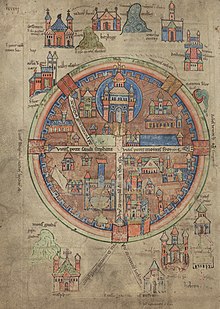Saewulf
Sæwulf (bl. 1102-1103) was an Anglo-Saxon pilgrim who visited the city shortly after the conquest of Jerusalem by the Crusaders (1099).
Apart from the pilgrimage report, nothing is known about his life . He wrote literarily undemanding Latin with the intention of describing Jerusalem and the pilgrimage destinations in the Judean Hills and Galilee to a readership far from the Holy Land .
Pilgrimage
The period of the pilgrimage can be inferred from the military conditions in Palestine, which Sæwulf's report assumes. Sæwulf belonged to a group of pilgrims who traveled by sea from Monopoli (near Bari ). Her ship cast off on July 13, 1102. About Corinth , Rhodes and Cyprus was Joppe reached.
The pilgrims were happy to go ashore after a storm at sea. But the two-day trip to Jerusalem took them through a dangerous area. Unburied corpses were seen and even an ambush by the Saracens had to be expected in the rocky terrain .
The group entered Jerusalem through the Jaffa Gate (then the Gate of David) and went straight to the Church of the Holy Sepulcher , whose chapels and shrines are honored in Sæwulf's account. Past S. Maria Latina, the city tour led Sæwulf to the temple grounds and on to St. Anne's Church, S. Maria in the Josaphat Valley and to Gethsemane . Sæwulf wandered out to the top of the Mount of Olives and then to Mount Zion . He saw the monastery of St. Sabas and the Church of the Nativity in Bethlehem . Next he mentioned the Church of Lazarus in Bethany and the Jordan . Hebron , Nazareth and Mount Tabor are the next stops on the pilgrimage. At the Sea of Galilee , Sæwulf visited various pilgrimage sites. He saw the Jordan springs at Caesarea Philippi .
After completing this round trip, Sæwulf's group of pilgrims went back to Joppe, where they boarded a ship on the day of Pentecost (May 17) 1103 that was supposed to take them home. For fear of the Saracen fleet, they did not dare to cross the Mediterranean, but sailed near the coast. Indeed , near Akko , enemy ships came within archery range. Two accompanying pilgrim ships took off so that Sæwulf's ship seemed easy prey for the Saracens. However, the two hundred or so combat-able pilgrims on board were determined to defend themselves and occupied the fort with armed men. When the Saracens watched these preparations, they turned away. So the pilgrim ship was able to continue its voyage to Cyprus, and an encounter with pirates also turned out to be safe. Then one sailed along the coast of Asia Minor and reached Constantinople in September 1103, whereby Sæwulf's manuscript breaks off.
identification
It is possible that the pilgrim Sæwulf is identical to the merchant Sæwulf mentioned by William of Malmesbury , who came from Worcester and joined the Malmesbury convent at the end of his life .
Lore
Only one copy of Sæwulf's pilgrimage report ( Relatio de peregrinatione Saewulfi ad Hierosolymam et Terram Sanctam ) has survived and is kept in Corpus Christi College, Cambridge (MS 111).
expenditure
- Robert BC Huygens: Peregrinationes tres (= Corpus Christianorum Continuatio mediaevalis Volume 139). Brepols, Turnholt 1994, ISBN 978-2-503-04391-3 .
- Palestine Pilgrims' Text Society (Ed.): Saewulf . Latin text and English translation by Canon Brownlow. London 1892.
literature
- Raymond Beazley: Sæwulf . In Dictionary of National Biography, 50, 1897, pp. 113-114. ( online )
- Sarah Hamilton: Church and People in the Medieval West, 900-1200 . Routledge 2013. ISBN 978-0-582-77280-9 . Pp. 290-293.
Web links
- Saewulf . Publications in the bibliographic database of the Regesta Imperii .
Individual evidence
- ↑ Information on the edition at Brepols
| personal data | |
|---|---|
| SURNAME | Saewulf |
| ALTERNATIVE NAMES | Sæwulf |
| BRIEF DESCRIPTION | Anglo-Saxon pilgrim |
| DATE OF BIRTH | 11th century |
| DATE OF DEATH | 12th Century |
